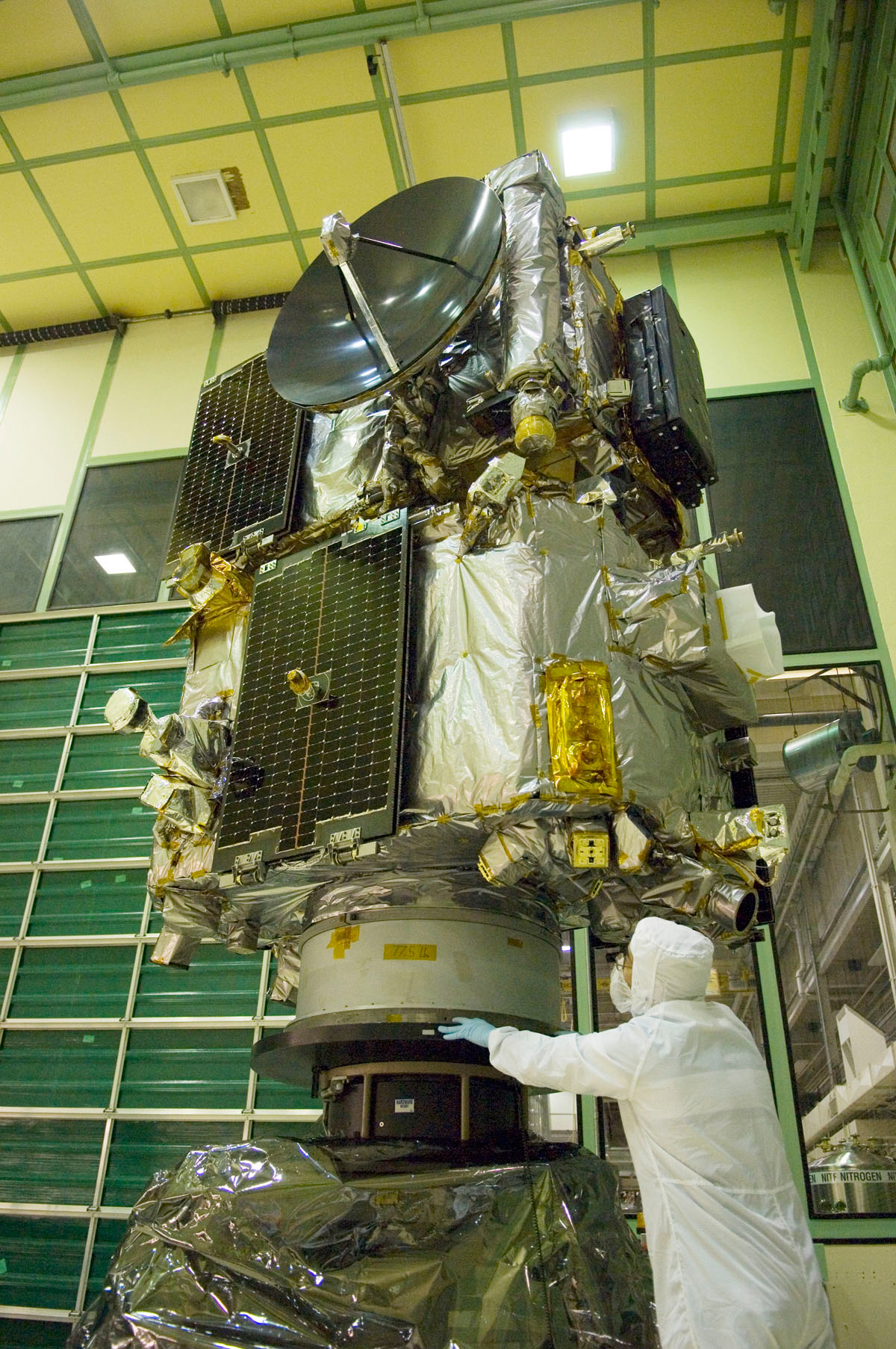
In February 2011, Academy of Program/Project and Engineering Leadership Director Ed Hoffman sat down with Rudi Schmidt, from the European Space Agency (ESA), and NASA’s Rob Manning at the Jet Propulsion Laboratory (JPL) as part of the Academy’s Masters with Masters series.

The Mars Science Laboratory rover, Curiosity, being prepared for March 2011 testing in a 25-foot-diameter space-simulation chamber.
Photo Credit: NASA/JPL-Caltech
Dr. Schmidt, the head of ESA’s Telecommunications Satellite Programs Department, was the project manager for several of ESA’s Directorate of Science and Robotic Exploration Programs, including Mars Express, Venus Express, and Gaia. Manning was formerly the Mars Exploration Program chief engineer at JPL and is currently the chief engineer for the Mars Science Laboratory (MSL).
Hoffman: What makes Mars so fascinating?
Manning: The Viking landers that arrived on Mars in the 1970s did sampling of the soil that was believed to tell us that the surface of Mars appeared to be a dead, sterile, boring place. But the Viking orbiters showed tantalizing hints that water may have coursed over the surface in huge deluges. Starting in the mid-90s, the Mars Global Surveyor mission showed signs that water may play an active role on Mars even in geologically recent time. We see what we think is water ice along with the CO2, and we see a dynamic atmosphere with huge dust storms. In the early nineties, I had this fantastic opportunity to become chief engineer for Mars Pathfinder. It allowed me to take all of my childhood desires, and all of the things I admired from the ten or twelve years of engineering, and put them together with a small team to build a vehicle to move around on the surface of Mars.
Schmidt: I never expected that I would end up leading a mission to Mars. I started in the European Space Agency in the early eighties as a scientist. I sat in my office doing data analysis, trying to conceive new ideas for new measurements of electric fields, magnetic fields, particles in space. Eventually, I became the project scientist for a mission called Cluster. I spent fourteen years working on that mission. We lost it within twenty seconds after launch in 96. When the Russian Mars 96 mission failed, some of the big European member states of the agency said, We have lost so much money, so much knowledge, so many instruments on Mars 96, we Europeans have to do our own mission. I was asked whether I would take over the preparation of Mars Express. At that point, nobody knew whether we could launch in 2003, whether the 150 million that we finally found would be sufficient to build an orbiter, launch, fly, and operate it. That preparation period lasted until maybe early 2000, when we said, Yes, we could launch in 2003. Yes, we can do it with 150 million. At that point, I became Mars Express manager.
It was the first deep-space mission which we did alone. Mars Express was a fully European spacecraft operated by us and implemented by us, with some NASA instruments on board. We did not know whether we had enough experience to carry it through, so we took quite a careful approach. I said to my people at that time, When I wake you up at two oclock in the morning, without any hesitation you have to give me your ten biggest risks. We built up lots of margin. Then politicians told us that we could not fly to Mars without a lander. All the reserves we had built up went to build Beagle 2, the lander.
Manning: That’s a lot of pressure, having the first Mars mission with a lander and the first mission that you had to do from scratch.

This false-color view was obtained by the Visible and Infrared Thermal Imaging Spectrometer onboard ESA’s Venus Express.
Photo Credit: ESA/VIRTIS/INAF-IASF/Obs. de Paris-LESIA
Schmidt: We had little budget and a small team. At that time there was a big mission called Rosetta, which was supposed to be launched about the same time. They would have all of the development technology and the Mars Express team would buy the current units. In the end, our small team was much more efficient than the bigger Rosetta team. We overtook Rosetta in terms of development, and the small Mars Express team started to drive the technology. It was quite challenging. In several instances you don’t have enough background to make a decision, but you know that the launch is coming and the decision has to be made.
Manning: My first Mars mission was Mars Pathfinder. We had a tiny budget, compared to the Viking missions. The best thing is having a small team. We were allowed to work in the shadow of a very large project, the Cassini mission. We were told to work in the faster-better-cheaper mode. We had to do a lander with very few, not-very-complicated requirements. It made for a very exciting environment because a small team could work very efficiently. Like Rosetta and Mars Express, we had Cassini technology that we could borrow from, but we beat them to the launchpad mostly because the planetary orbit demanded it but also because we were small and much more agile. Unlike your project, we didn’t have a lot of eyes looking at us.
Hoffman: How does a program change when you’re managing a small team?
Manning: You constrain the mission objectives, keep the system as simple as you dare, but no simpler, and give yourself healthy reserves. We initially had 50 percent cost reserves. Obviously, from NASA’s perspective you don’t know what you’re doing if you’re asking for 50 percent reserves. That’s correct, we didn’t. We had never done a low-cost lander and rover before. We spent every penny of that 50 percent, by the way. On the other hand, the risk model we were working with was not the same one we would use today. We had very little redundancy, with just a few key places where we felt there were high-risk components: pyrotechnic devices, the radio transmitter, and a few other places.
Schmidt: After Mars Express, I am a fan of small project teams because they are efficient. A small team driven by launch date and constrained by cost has to be innovative. Our starting point was different from Rob’s because Mars Express is the child of a failure. We could not fail again. The inspector general reviewed us over and over again to make sure our margins, reserves, design assumptions, and requirements were all tight. In the end, it worked out well.
Manning: Larger projects have more instruments, they have a more complex mission definition, there’s just more you have to manage. It’s not just a scale-up. There are more interfaces that you have to deal with. As a consequence, you have to use more rigorous systems engineering techniques so that the various things that are going on in parallel succeed and come back and meet you at the end. For a smaller mission, you have fewer things to manage. As a consequence, you can apply different management disciplines to improve efficiency without necessarily changing the risk posture. In some cases—for example, MSL—we were asked to put a lot of redundancy in, approaching the redundancy of some traditional, large, flagship missions. That means you have twice as much equipment to build, more to integrate, more different permutations of testing to do. There’s a lot more complexity you have to manage.
Schmidt: I’m not sure I fully agree with you. My budget following Mars Express was about five times Mars Express. The project team size was far from five times bigger than the Mars Express project. Instead of twelve people, it was seventeen. I like small, horizontal teams. That means people close to the project manager, a straight information path from the lowest member in the project team up to the project manager. Each person in the team feels responsible and knows that they have immediate access to the project manager in case of a problem.
Hoffman: Do you learn most when things don’t go right?
Manning: The great thing about failure is that people start believing you when you say there are issues you need to solve and you need the resources to solve them. In a project that is so cost-constrained that they can’t afford to even assess the risk, you’re getting on thin ice. You need to have not just done the work, but to have it reviewed with independent people who make sure that you didn’t forget anything. MER [Mars Exploration Rover] was much more complex than Pathfinder, and we were paying not just for hardware, but for additional work and double checking.

Elevation of Ulyxis Rupes created using a digital terrain model obtained from the high-resolution stereo camera on ESA’s Mars Express spacecraft.
Photo Credit: ESA/DLR/FU Berlin
Hoffman: Rob, when you were going through the Mars Exploration Rover lessons learned, you said that one of the things that stuck out to you was sometimes you just need to stop and reflect.
Manning: Yes, having a little extra help so that there are key people who really understand the design and you can stop and ask, “Did we really think this through?” On Phoenix, even though the design was directly based on the Mars Polar Lander, we bought ourselves some time and people to think through the entry, descent, and landing problem. We said, “Let’s take the design and analyze and test it as if it were brand new.” In the process, we learned new things about Phoenix and about Mars Polar Lander.
Hoffman: How do you balance managing risk and being able to innovate?
Manning: If we can get to our objective with something that’s tried and true, we will do it. But if there’s a new technology that we need to succeed, we will put our heart and soul into making it happen. A lot of people say, “Why didn’t you throw this technology in as well?” Well, because I can do this mission with a technology where I’ve already retired the risks. In the case of MER, we said we are going to use all that technology from Mars Pathfinder and adapt it with minimal or no changes. In fact, all the hardware had to be redesigned in order to meet the mission objectives. Less than 1 percent of the total mass of what we launched was heritage hardware from prior missions. We had to change everything a little bit to deal with larger landed masses. Even so, the knowledge of what was learned on Mars Pathfinder directly reduced the risk on MER, but it did add to cost. You just have to be quick on your feet and willing to learn. When you find information that tells you your assumptions were wrong, don’t hold on to them. Throw them away, learn the new ones, and go forward.
Schmidt: The plan was that we procure recurring units developed by Rosetta and that we re-fly the instruments of Mars ’96. The reality was the scientists said, “We need new instruments because we learned so much in building the first set of instruments that now we’ll do it differently.” We couldn’t stop the scientists developing new things because the payload was under member-state control. One day, relatively late in the project, the scientists came with the idea to change the orbit. This is the last thing you want because all your computations, all of your modeling, all your operational documents are written for a certain orbit. I must admit, quite often we found what I originally thought was a pretty stupid idea turned out to be implementable one way or another. But it doesn’t make your life easy if you keep changing what you thought is a solid goal post. That’s the result of working with people. People change their mind and you have to adapt.
After Mars Express, I am a fan of small project teams because they are efficient. A small team driven by launch date and constrained
by cost has to be innovative. Our starting point was different from Rob’s because Mars Express is the child of a failure. We could not fail again. The inspector general reviewed us over and over again to make sure our margins, reserves, design assumptions, and requirements were all tight. In the end, it worked out well.
Hoffman: Aerobraking is obviously one of the breakthrough technologies in your area of expertise.
Manning: The great thing about entry, descent, and landing is that there is a heritage to build upon—a technological heritage, not a hardware heritage. The Viking missions developed something called SLA 561V, which is similar to the sprayon ablative heat-shield material used on the shuttle external tanks. This material was validated and tested thoroughly in the years leading up to the Viking launch. We were able to adapt that technology to very different conditions. We had to make it thicker, we had to redefine the formula after the twenty-year hiatus, but we used that same technology, the parachute technology, the whole structure of how to get rid of your heat shield and get out of your vehicle, undress yourself in a few seconds in a very dynamic environment. On MSL, technology that we had relied upon for many years for many missions suddenly didn’t work. Mars Science Laboratory has a four-and-a-half-meter-diameter heat shield, the largest circular heat shield anyone’s ever built. When MSL flies through the Mars atmosphere, its radiative heating environment and the shear dynamics are so great that the old technology just doesn’t work. So we had to come up with a whole new technology and adapt the PICA heat-shield material that we used on Stardust. That was a huge left turn, but it was done with our eyes wide open. For a project manager, it’s very scary going from the devil you knew to a devil you don’t, but this devil has worked out very well so far.
Schmidt: Because Mars Express moved forward nicely, the project team had the idea to build a second Mars mission for launch in 2005 with all the leftovers. We naïvely assumed it was going to be a second Mars mission. But the director said we have to do a competition, we have to open it to all communities. So the ideas came back, and what did we get? A Venus mission. We needed a new solar array. We needed a completely new thermal system. So we bought ourselves a lot of problems, but in the end we also made this mission successful.

One of a super-resolution stereo pair of “Twin Peaks” taken by the imager for Mars Pathfinder.
Photo Credit: NASA/JPL/Timothy Parker
Hoffman: How do you work effectively when you have so many different stakeholders involved in something that’s naturally complex?
Schmidt: The needs of all the member states involved in the mission are a priority. It means you’re not always getting a certain piece of hardware from the best company; you have to make compromises, you have to be sure that enough money went to various countries according to certain computations. It’s a big fraction of my daily business; it’s the price of being a European. And because the cultures are different, the experience of the companies is different. And you have to build up an industry in new member states. We recently had a case where one of the project engineers was assigned to a company as a kind of resident. He trained them, he showed them, he explained to them, and in the end the hardware came—a week late, but working perfectly. The next time around this company will have a good chance to win the competition.
Hoffman: Rob, obviously NASA has been increasingly involved in international missions. What are the benefits?
Manning: From a parochial perspective, sharing the cost of a project. We have been looking at collaborating on a Mars sample return for years. We have European science instruments on board Mars Science Laboratory. We aren’t as good as Europeans are at managing these complicated relationships. We are used to being able to solve the problems directly, finding the best, cheapest company, and having the control on our side. But the flip side is that having a partner can produce significant contributions. Our biggest challenge is how to do technically challenging and exciting, high-return missions across international boundaries, especially given ITAR [International Traffic in Arms Regulations]. It can be done. The Huygens-Cassini mission is a perfect example. It was a fantastic relationship.
Schmidt: I think it is relatively easy for European scientists to build international teams because they have to bring in their own money. I have seen PIs [principal investigators] coming in with a team proposal which included scientists from all continents. I am impressed by the capabilities of the scientists to put together these extremely complicated instrument proposals with complicated team structures behind them.
The things we want to do now are harder and harder: bringing things back from another planet, going to asteroids, going and staying at
Jupiter, landing on Europa. Cost sharing makes a lot of sense.
Manning: The things we want to do now are harder and harder: bringing things back from another planet, going to asteroids, going and staying at Jupiter, landing on Europa. Cost sharing makes a lot of sense.
Hoffman: Both of you have work that you love. What is it you love the most about what you do?
Schmidt: I am really grateful the European Space Agency gave me the opportunity to work on the most fascinating missions. We had the first interplanetary mission under our own control, and we went to Venus with Venus Express. We had a Mars orbiter, we had a Venus orbiter, and then, of course, we have the Earth-observation program. So we monitored three planets totally different in terms of atmosphere evolution and environment evolution.
Manning: The best part was being there for the revolution of rediscovering Mars. The whole unfolding from one mission to another, including Mars Express, Mars Reconnaissance Orbiter, the Odyssey mission, on and on, every mission has turned over a whole page of understanding about this planet. And we have gone from an almost cartoonish view of what Mars was to an encyclopedic understanding of Mars. Of course, each new page brings up new questions. Being part of that revolution has been very exciting for me.








